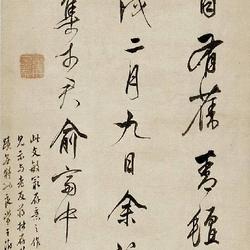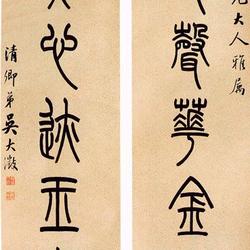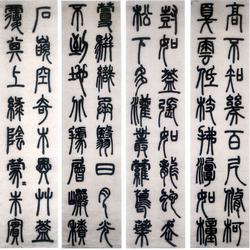Zhao Zhiqian's seal script is a collection of Xu's essays and narratives. Paper, length 32.4cm, width 57.5cm. 10 lines per page, 4 words per line. This volume of seal script contains an excerpt from Xu Shen's "Shuowen Jie Zi Shu" of the Han Dynasty. At the end, it says: "Fanghu belongs to this volume of the book, so the pen marks are exposed to show the beginning and end of the book." Signed: "Zhiqian", inscription The seal of "Zhao's Qian" is stamped on it. There is no identification mark and no record.
It is inferred from Zhao Zhiqian's knowledge that this volume should be a model for his disciples to practice calligraphy, and the "Fang Hu" in the top paragraph should be his disciple or someone who loves his calligraphy. The calligraphy structure of this book is rigorous, and the seal writing is exquisite. No hidden edges are used at the beginning and end. This is intended to make it easier for disciples to see the traces of the calligraphy, but it has an unexpected effect, making it different from the roundness and beauty of ordinary seal writing. It has its own characteristics. At the same time, the writing in this book is strong and powerful, and it can be turned freely. The Beibei calligraphy is integrated into the seal script, which is also a major feature of Zhao's calligraphy. The specific writing time of this volume is unknown, but judging from the calligraphy style and the writing examples for his disciples, it is believed to be a work written by Zhao after his middle age, and it is one of Zhao Zhiqian's representative seal script works.
Interpretation: Cangjie, the historian of the Yellow Emperor, saw the traces of the hooves of birds and animals, and knew that the principles could be distinguished from each other. When the written deed was first made, hundreds of officials reviewed it, and all the people inspected it. All the merits were collected and presented in the royal court. Those who speak in words should preach and make it clear to the king. The gentlemen of the court should be generous and generous, and those who live in virtue should be taboo. When Cangjie first wrote books, they were based on pictograms, so they were called wen. Then the shape and sound complement each other, which is called the word. The word "brother" means that it breeds milk and soaks in too much. Written in a book called Zhubo. The book is like this. After the era of the Five Emperors and Three Kings, they changed their bodies and were granted the title of Qinshan. There are two generations in the seventy and the same. When Zhou Li entered primary school at the age of eight, Bao Shi taught Guozi the Six Books. One word refers to things. Those who refer to things can be recognized by looking at them, and they can be seen by observing them, up and down. The second is pictography. Pictograms are drawn into their objects, and they are interrogated according to the body, such as the sun and the moon. The third is the phonetic sound. The phonetic sounds are named after things, and they are complementary to each other, as is the case with rivers. The fourth is understanding. Those who know each other's minds are likened to friendship, and see and point to each other. This is also true of Wu Xin. The fifth day is transfer. Those who transfer notes, build the same genre, agree to accept each other, and always test. The sixth is to borrow. Those who borrowed it under the guise have no actual words. They rely on the voice to entrust things, and the commander-in-chief is so. As for King Xuan Taishi, he wrote fifteen large seal scripts, which may be different from the ancient texts. Confucius wrote the Six Classics and Zuo Qiu Ming Shu Chun Qiu Zhuan, all of which were based on the meaning of the ancient texts. Xu Shuowenxu.


















